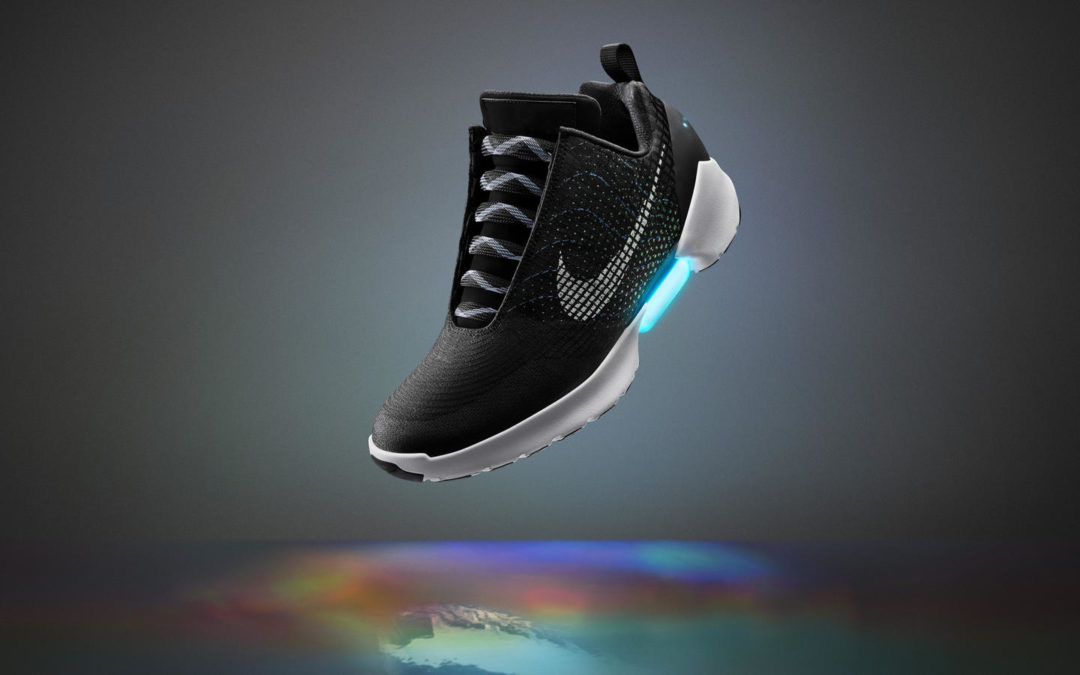The IoT In Real Life
In “Back to the Future II,” Marty McFly traveled to the future (to his future, our past–Oct. 21, 2015). While he was there he was given self-lacing tennis shoes.
And those shoes were amazing.
Whether you’ve seen the movie once or a hundred times, one of the images that imprints itself on the mind the most is the shot of McFly’s new shoes tightening around his feet with an octopus-like sucking sound as the shoes lace themselves to perfect comfiness.
Sure, the hoverboard and the flying DeLorean get most of the nostalgia attention from that movie, but we all loved the shoes.
CNET, in a feature about these shoes, noted how last year, on October 21, 2015–on Back to the Future Day–Nike sent a humble little package to Michael J. Fox as a way to commemorate his role in one of the most popular films of all time.
And inside the package?
Self-lacing shoes, just like the movie.
Nike had done it.
 And now in 2016 those shoes, called the HyperAdapt 1.0, have been announced to the world. They will become available to consumers (only members of Nike+) in late 2016. And yes, that 1.0 means exactly what you think it means. They are going full-on iShoe. They’re doing it Apple and Marvel Cinematic Universe style, which means we can expect endless versions of the HyperAdapt shoe until the world ends. (HyperAdapt 12.0 will probably drive your car for you, send flowers to your significant other on your anniversary, and talk to you when you’re lonely.)
And now in 2016 those shoes, called the HyperAdapt 1.0, have been announced to the world. They will become available to consumers (only members of Nike+) in late 2016. And yes, that 1.0 means exactly what you think it means. They are going full-on iShoe. They’re doing it Apple and Marvel Cinematic Universe style, which means we can expect endless versions of the HyperAdapt shoe until the world ends. (HyperAdapt 12.0 will probably drive your car for you, send flowers to your significant other on your anniversary, and talk to you when you’re lonely.)
IoT Hits the Ground Running
In all seriousness, the prospect of future versions does have wider implications than just a shoe that saves you the trouble of hunching over to tie or tighten your laces. Nike has genuine Internet of Things ambitions with this shoe. As Tinker Hatfield of Nike says in a recent Nike press release:
[Hatfield] concludes, “Wouldn’t it be great if a shoe, in the future, could sense when you needed to have it tighter or looser? Could it take you even tighter than you’d normally go if it senses you really need extra snugness in a quick maneuver? That’s where we’re headed. In the future, product will come alive.”
Nike’s press release sums it up this way: “In short, the Nike HyperAdapt 1.0 is the first step into the future of adaptive performance. It’s currently manual (i.e., athlete controlled) but it makes feasible the once-fantastic concept of an automated, nearly symbiotic relationship between the foot and shoe.”
So how does it work exactly?
You place your foot in the shoe, and, immediately, sensors are activated by your heel, and the system automatically tightens. From that point there are two buttons, one to tighten the shoelaces one to loosen, on the side of the shoe that allow you to fine-tune the feel of the shoe. The designers note that this solves the slippage problem. Shoe slippage can negatively affect an athlete’s performance as the stress placed on a normally laced shoe causes the laces to loosen. The HyperAdapt allows athletes to maintain perfect tightness at all times.
The casing that houses its technical components can be seen on the underside of the shoe, a small box or compartment as if a battery were embedded near the thickest part of the heel. It looks secure and well protected–a small rectangular rubber fortress nestled snug within the heart of the HyperAdapt. It looks as if they positioned the small box of technology, and its sturdy rubber encasement, to actually help provide cushion for the foot–two birds with one stone, it seems.
Although Nike won’t provide a detailed tell-all of the technology, it is described as an “under-foot lacing system,” and Nike made use of advanced research in digital, electrical and mechanical engineering to make it work. The biggest challenge was placing the resulting technical components into a packet that could remain comfortable for the foot while absorbing high performance impact from the athlete.
Hatfield of Nike said this about the final version of HyperAdapt–and where they intent to go with it: “It is amazing to consider a shoe that senses what the body needs in real-time. That eliminates a multitude of distractions, including mental attrition, and thus truly benefits performance.”



Subscribe To Our Newsletter
Join our mailing list to receive the latest news and updates from our team.
You have Successfully Subscribed!